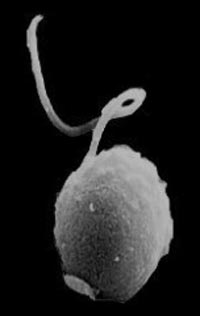Microscopic Indigestion Caught in the Act

Dalhousie University.<br> <br>Bigelowiella natans, a type of algae decoded in the study.<br>
Microbial evolutionary theory suggests that about a billion years ago, microbes ingested other organisms with photosynthetic properties and used those 'captives' as solar powered food factories to supply themselves with nutrition.
This ingestion would eventually result in the original microbe becoming capable of photosynthesis, and the remnants of the 'captive' organism would disappear. The process is said to have produced the biodiversity in our oceans that underpins ocean food webs and contributes to atmospheric balance.
However, there hasn't been much evidence to support that this microscopic ingestion was what ultimately produced the sort of organisms that rely on photosynthesis today.
The study of two enigmatic and complex groups of algae has uncovered this process in action. Now scientists are able to see an organism operating photosynthetically, while still being able to detect two very distinct genetic blueprints, revealing how two very different organisms once merged at the genetic level.
This discovery adds further evidence to support the theory that much of the photosynthetic life on earth and the resulting biodiversity began because of two organisms merging, via ingestion of one by another.
“The reason why these two genomes are of significance and importance to the scientific world is that they give us more insight into how that process happened. Because normally, the captured cell, most of it disappears, and only the important parts—being the photosynthetic apparatus—remains,” says Dr. Bruce Curtis, first author of the study. “But in the case of these two organisms, they didn’t go to completion. So we see the process in action, so to speak.”
The study (published in Nature, November 28): Algal genomes reveal evolutionary mosaicism and the fate of nucleomorphs.
Media Contact
More Information:
http://www.dal.caAll latest news from the category: Life Sciences and Chemistry
Articles and reports from the Life Sciences and chemistry area deal with applied and basic research into modern biology, chemistry and human medicine.
Valuable information can be found on a range of life sciences fields including bacteriology, biochemistry, bionics, bioinformatics, biophysics, biotechnology, genetics, geobotany, human biology, marine biology, microbiology, molecular biology, cellular biology, zoology, bioinorganic chemistry, microchemistry and environmental chemistry.
Newest articles

Superradiant atoms could push the boundaries of how precisely time can be measured
Superradiant atoms can help us measure time more precisely than ever. In a new study, researchers from the University of Copenhagen present a new method for measuring the time interval,…

Ion thermoelectric conversion devices for near room temperature
The electrode sheet of the thermoelectric device consists of ionic hydrogel, which is sandwiched between the electrodes to form, and the Prussian blue on the electrode undergoes a redox reaction…

Zap Energy achieves 37-million-degree temperatures in a compact device
New publication reports record electron temperatures for a small-scale, sheared-flow-stabilized Z-pinch fusion device. In the nine decades since humans first produced fusion reactions, only a few fusion technologies have demonstrated…





















